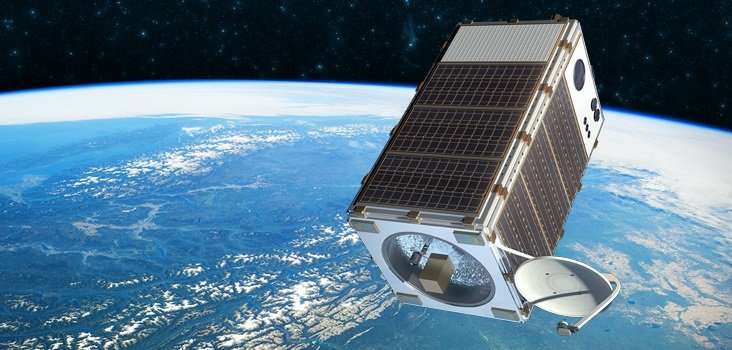Environmental defense fund develops methane-hunting satellite

Environmental Defense Fund (EDF), a U.S.-based nonprofit environmental advocacy group, intends to launch a new satellite designed to measure methane emissions worldwide. The spacecraft, named MethaneSAT, could offer a substantial help for countries and companies in combating global warming.
MethaneSAT project was unveiled by EDF President Fred Krupp on April 11, 2018. He presented the plan of developing a methane-hunting satellite during a TED Talk in Vancouver, British Columbia, Canada. MethaneSAT was described by Krupp as the newest chapter in EDF's ongoing effort to advance peer-reviewed science focused on oil and gas methane emissions.
"We believe in the power of cutting-edge science to change the world, producing actionable data that can greatly increase businesses' and government's ability to make effective policy decisions. Transparent data that shows where there are problems and opportunities creates faster and more effective solutions. MethaneSAT will provide global high-resolution coverage, exceeding anything in orbit or on the drawing board today," Krupp told Astrowatch.net.
MethaneSAT is planned to be about the size of a small, dorm-size refrigerator. However, despite its compact size, the spacecraft will involve significant advances on existing technology, in both the design of the instrument on the satellite and the data processing solutions. This, according to Krupp, is necessary to turn its vast stream of raw data into actionable science that oil and gas companies, governments, investors and others can use to shape and evaluate emissions reduction strategies.
"As a core part of the project design, EDF plans to make MethaneSAT data available for free to stakeholders and the public, engaging the oil and gas industry, key governments, institutional and individual investors, and regional and global institutions to ensure sustained long-term data analysis and integration of the results into their thinking on emissions mitigation and verification," Krupp said.
MethaneSAT is being designed to be capable of identifying and measuring methane emissions from human-made sources worldwide, starting with the oil and gas industry. The satellite would use a wide, 200 kilometer view path at intervals of seven days or less, making it feasible to regularly monitor roughly fifty major oil and gas regions accounting for over 80 percent of global production. MethaneSAT would also measure emissions from feedlots, landfills, and other man-made methane sources.
All in all, EDF develops MethanSAT as an Earth-orbiting instrument that should be capable of pinpointing the location and magnitude of methane emissions virtually anywhere on our planet. Such tool could be crucial for reducing methane pollution worldwide.
"Cutting methane emissions from the global oil and gas industry is the single fastest thing we can do to help put the brakes on climate change right now, even as we continue to attack the carbon dioxide emissions most people are more familiar with. By providing reliable, fully transparent data on a worldwide scale, MethaneSAT will help transform a serious climate threat into a crucial opportunity," Krupp explained.
He added that the MethaneSAT project defies current paradigms in orbital detection as most satellites originate either from research and space organizations. When it comes to MethaneSAT, it combines the economic advantages of each model. Furthermore, because it will focus only on methane, it will be quicker and less expensive to launch than the complex, multi-function satellites built by government space agencies.
Krupp plans to launch MethaneSAT into space in late 2020 or early 2021. In order to achieve this goal, EDF hired Tom Ingersoll, a successful satellite entrepreneur with three decades of experience. Ingersoll was previously CEO of Skybox Imaging and Universal Space Network, a global satellite ground-station services company. Krupp believes that with Ingersoll's help the project will be completed on schedule.
EDF has also partnered with Harvard University and the Smithsonian Astrophysical Observatory (SAO) to complete the basic science and technical strategies for the mission, and expect to complete final mission requirements and set an exact launch schedule later this year.
So far, MethaneSAT has completed phase 0 development, concluding basic science requirement development by Harvard University and SAO, and a conceptual design confirming the science strategy is sound.
"We have entered phase A, which will result in finalized mission requirements, key design selections, a refined budget, and launch schedule. We expect to complete this phase later this year," Krupp concluded.
EDF underlines that a 45 percent reduction in oil and gas methane emissions by 2025 would deliver the same 20-year climate benefit as closing one-third of the world's coal-fired power plants. The organization notes that it is the fastest, most cost effective thing we can do to slow climate change right now and MethaneSAT is will be an incredibly valuable tool for achieving that goal.
EDF has also engaged with ten oil and gas companies representing 20 percent of worldwide production that together formed the Oil and Gas Climate Initiative (OGCI) around methane issues, and worked with governments and industry to catalyze the Oil and Gas Methane Partnership (OGMP), a coalition of eight global producers committed to better reporting to reduce methane emissions. Data from MethaneSAT could take this process for positive change to the next level.
Provided by Astrowatch.net



















